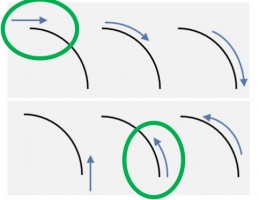Up And Down And Along: How We Interact With Curvature
in Workshop 'Displays Take New Shape: An Agenda for Interactive Surfaces' in conjunction with the 31st ACM SIGCHI Conference on Human Factors in Computing Systems (CHI '13), Paris, France, April 27 - May 2, 2013.
Non-flat interactive displays have one very distinct property that differs from the touch displays we use on tablets or smartphones: the spatial structure that defines their non-flatness. In this paper, we investigate one specific class of spatial structure planes bent in one dimension with both concave and convex curvature. We study horizontal pointing and dragging along those bends to see how it differs from flat displays. Structure can also enable new interactions that have not been possible with flat displays, e.g. perceivable vertical dragging across a horizontal structure. Overall, we found that accuracy of interaction as well as subjective preference can be increased, and that the new interactions can enhance existing direct touch control.
Non-flat interactive displays have one very distinct property that differs from the touch displays we use on tablets or smartphones: the spatial structure that defines their non-flatness. In this paper, we investigate one specific class of spatial structure planes bent in one dimension with both concave and convex curvature. We study horizontal pointing and dragging along those bends to see how it differs from flat displays. Structure can also enable new interactions that have not been possible with flat displays, e.g. perceivable vertical dragging across a horizontal structure. Overall, we found that accuracy of interaction as well as subjective preference can be increased, and that the new interactions can enhance existing direct touch control.

